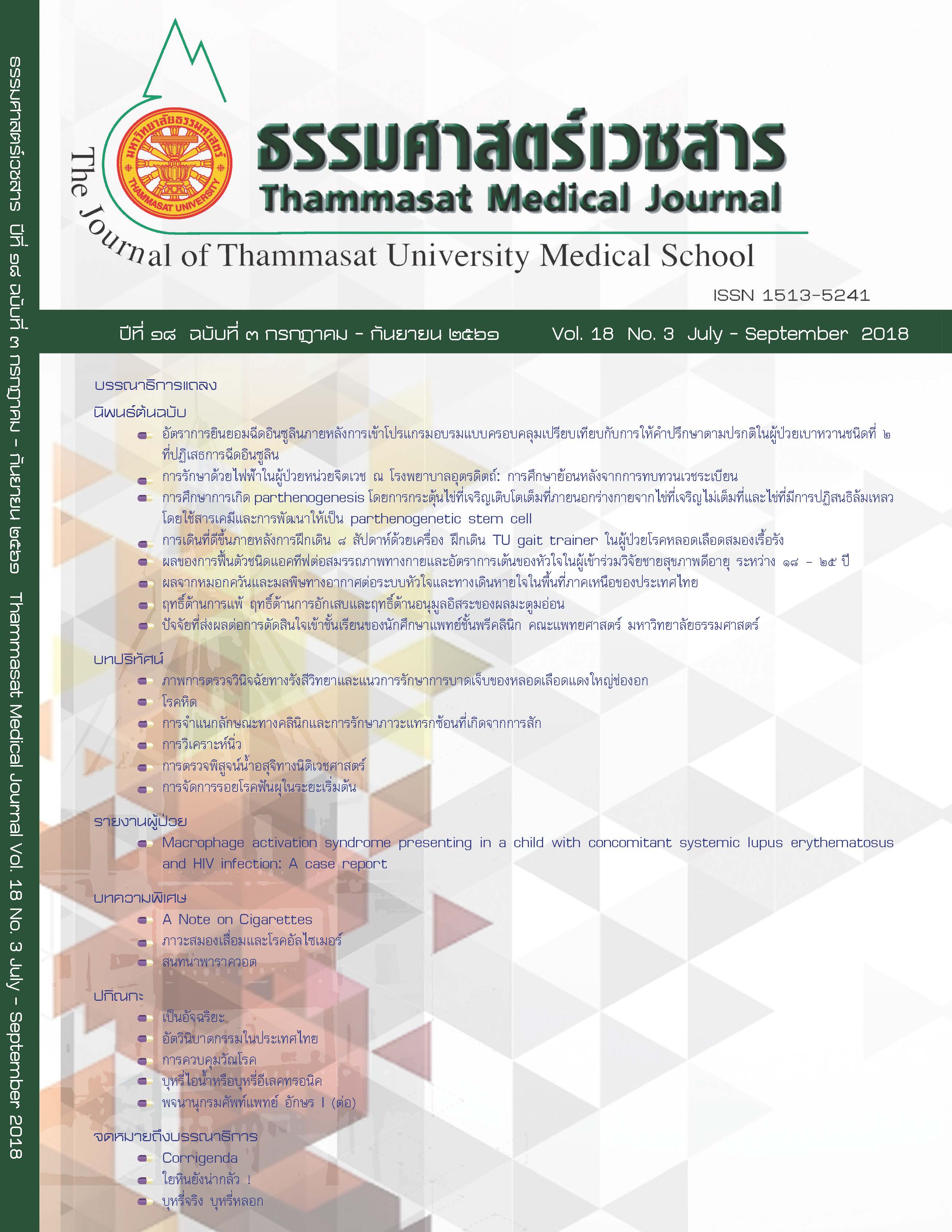The study of parthenogenesis of immature oocytes with in vitro maturation and fail-fertilized mature oocytes by chemical activation and the preliminary study of parthenogenetic derived stem cell
Keywords:
parthenogenesis, parthenogenetic activation, parthenogenetic culture, blastocyst, stem cellAbstract
Introduction: Parthenogenesis is a process of transforming from haploid gamete to diploid cell without fertilization process of sexual reproduction. Human parthenogenetic derived stem cell is an ethical advantage alternative resource of human embryonic stem cell for medical research application. However, the human parthenogenesis is very rarely occurred. To study the parthenogenetic activation and culture protocols of immature oocytes with in vitro maturation (IVM) and fail-fertilized mature oocytes.
Method: The immature oocytes and fail-fertilized oocytes donated from infertile couples treated with assisted reproductive technology at Thammasat University Hospital during the years 2014 - 2017 were activated by 2 chemical activation protocols. Protocol I was composed of ionomysin + 6-dimethylaminopurine (6-DMAP) and Protocol II was ionomysin + cytochalasinB (CB) and cycloheximide (CHX). After activation, all oocyte in both protocols were studied further according to the result of preliminary study as the following: Protocol I The oocytes were cultured with culture medium for 5 days only (regimen A), Protocol II The oocytes were culture with culture medium for 5 days only (regimen A), The oocytes were culture with culture medium for 5 days plus growth factors (regimen B), The oocytes were culture with culture medium for 5 days with growth factors and electrofusion at days 3 (D3) (regimen C) The obtained parthenogenetic blastocysts were aimed to be used for preliminary parthenogenetic derived stem cell study. The parthenogenetic pronuclear (PPN), the cleavage (PC) and blastocyst (PB) rate were compared between subgroups, by Student T test with the level of significance at 0.05.
Result: Total of 191 oocytes studied were 110 immature oocytes (79 fresh and 31 frozen-thawed), 81 fail-fertilized mature oocytes (74 fresh and 7 frozen-thawed). The PPN rate of total oocytes and fresh immature oocytes especially in germinal vesicle sub group with IVM in protocol I were lower significantly than those of in Protocol II (51.80%, 40.00% and 40.63% vs 69.44%, 69.23% and 72.73%; p = 0.013, 0.008 and 0.004 respectively). The PC rate of total oocytes and fail-fertilized mature oocytes in protocol I regimen A were significantly lower than those of in protocol II regimen B (65.12% and 57.14% vs 86.66% and 100.00%, p = 0.001 and 0.005 respectively). The PC rate in protocol II of total oocytes with regimen A was significantly lower than that of with regimen B (78.67% and 86.66%, p = 0.014). The PC rate of immature oocytes with IVM in protocol I regimen A was significantly lower than that of in protocol II with regimen A (75.00% and 95.59%, p = 0.001). The PB rate in this study was 4.19%. The PB rate of fresh immature oocytes with IVM was 4.71%. The PB rate of fresh fail-fertilized matured oocytes was 4.88%. The PB rate in protocol II of total oocytes with regimen A was significant lower than that of with regimen B (5.53% vs 6.67%, p=0.05). There was no parthenogenetic derived stem cell successfully developed in this study.
Discussion and Conclusion: The results of parthenogenetic activation of fresh immature oocytes with IVM with ionomysin + CB + CHX were better than that of ionomysin + 6DMAP. The parthenogenetic blastocyst could be activated by different chemical oocyte activation and culture protocols with some better results from ionomysin +CB + CHX activation and cultured in culture medium with growth factors. Anyhow, the parthenogenetic derived stem cell would be required further study due to the limit number of parthenogenetic blastocyst yield.



